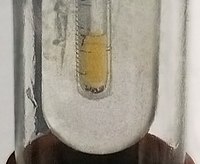
Photo from wikipedia
Metal-free carbon materials have been presented to be potential alternatives to metal-based catalysts for heterogeneous catalytic ozonation, yet the catalytic performance still needs to be enhanced. Doping carbon with non-metallic… Click to show full abstract
Metal-free carbon materials have been presented to be potential alternatives to metal-based catalysts for heterogeneous catalytic ozonation, yet the catalytic performance still needs to be enhanced. Doping carbon with non-metallic heteroatoms (e.g., N, B, and F) could alter the electronic structure and electrochemical properties of original carbon materials, has been considered to be an effective method for improving the catalytic activity of carbon materials. Herein, fluorine-doped carbon nanotubes (F-CNTs) were synthesized via a facile method and characterized by X-ray diffraction (XRD), X-ray photoelectron spectroscopy (XPS), and Raman spectroscopy. The as-synthesized F-CNTs exhibited notably enhanced catalytic activity towards catalytic ozonation for the degradation of organic pollutants. The oxalic acid removal efficiency of optimized F-CNTs was approximately two times as much as that of pristine CNTs, and even exceeded those of four conventional metal-based catalysts (ZnO, Al2O3, Fe2O3, and MnO2). The XPS and Raman studies confirmed that the covalent CF bonds were formed at the sp3 C sites instead of sp2 C sites on CNTs, not only resulting in high positive charge density of C atoms adjacent to F atoms, but remaining the delocalized π-system with intact carbon structure of F-CNTs, which then favored the conversion of ozone molecules (O3) into reactive oxygen species (ROS) and contributed to the high oxalic acid removal efficiency. Furthermore, electron spin resonance (ESR) studies revealed that superoxide radicals (O2-) and singlet oxygen (1O2) might be the dominant ROS that responsible for the degradation of oxalic acid in these catalytic systems.
Journal Title: Chemosphere
Year Published: 2018
Link to full text (if available)
Share on Social Media: Sign Up to like & get
recommendations!